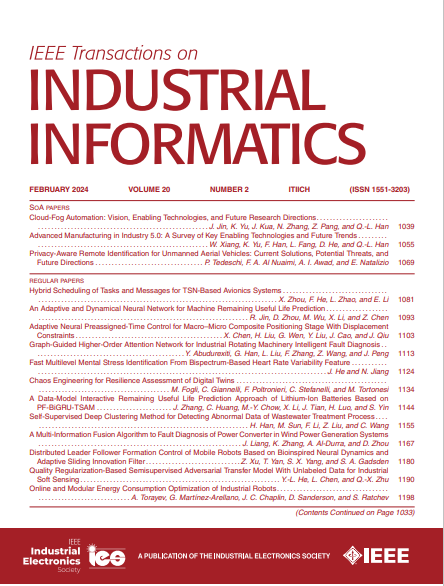基于单模态和跨模态融合的多模态工业异常检测
IF 11.7
1区 计算机科学
Q1 AUTOMATION & CONTROL SYSTEMS
引用次数: 0
摘要
在2D-3D多模态异常检测(MAD)方法中,利用RGB图像(RGB)和点云(PT)构建综合的多模态特征表示对于揭示各种类型的工业异常非常重要。对于多模态表示,现有的MAD方法大多考虑了通过空间对齐融合从RGB和PT提取的模态特征之间的显式空间对应关系,而忽略了它们之间的隐式交互关系。在本研究中,我们提出了一种单模态和跨模态融合(UCF)方法,该方法综合了多模态表征中模态内部和模态之间的隐式关系。具体来说,UCF首先建立单模态和跨模态嵌入,通过单模态重构和跨模态映射来捕捉模态内和多模态关系。在此基础上,提出了一种自适应非等融合方法进行融合嵌入,以保持单模态和跨模态嵌入的基本特征并减少干扰。最后,通过单模态、跨模态和融合嵌入来揭示存在于不同模态中的异常。在MVTec 3D-AD基准测试和实际表面贴装检测上进行的实验表明,所提出的UCF优于现有方法,特别是在精确异常定位方面。本文章由计算机程序翻译,如有差异,请以英文原文为准。
Multimodal Industrial Anomaly Detection via Uni-Modal and Cross-Modal Fusion
Constructing comprehensive multimodal feature representations from RGB images (RGB) and point clouds (PT) in 2D–3D multimodal anomaly detection (MAD) methods is very important to reveal various types of industrial anomalies. For multimodal representations, most of the existing MAD methods often consider the explicit spatial correspondence between the modality-specific features extracted from RGB and PT through space-aligned fusion, while overlook the implicit interaction relationships between them. In this study, we propose a uni-modal and cross-modal fusion (UCF) method, which comprehensively incorporates the implicit relationships within and between modalities in multimodal representations. Specifically, UCF first establishes uni-modal and cross-modal embeddings to capture intramodal and intermodal relationships through uni-modal reconstruction and cross-modal mapping. Then, an adaptive nonequal fusion method is proposed to develop fusion embeddings, with the aim of preserving the primary features and reducing interference of the uni-modal and cross-modal embeddings. Finally, uni-modal, cross-modal, and fusion embeddings are all collaborated to reveal anomalies existing in different modalities. Experiments conducted on the MVTec 3D-AD benchmark and the real-world surface mount inspection demonstrate that the proposed UCF outperforms existing approaches, particularly in precise anomaly localization.
求助全文
通过发布文献求助,成功后即可免费获取论文全文。
去求助
来源期刊

IEEE Transactions on Industrial Informatics
工程技术-工程:工业
CiteScore
24.10
自引率
8.90%
发文量
1202
审稿时长
5.1 months
期刊介绍:
The IEEE Transactions on Industrial Informatics is a multidisciplinary journal dedicated to publishing technical papers that connect theory with practical applications of informatics in industrial settings. It focuses on the utilization of information in intelligent, distributed, and agile industrial automation and control systems. The scope includes topics such as knowledge-based and AI-enhanced automation, intelligent computer control systems, flexible and collaborative manufacturing, industrial informatics in software-defined vehicles and robotics, computer vision, industrial cyber-physical and industrial IoT systems, real-time and networked embedded systems, security in industrial processes, industrial communications, systems interoperability, and human-machine interaction.
 求助内容:
求助内容: 应助结果提醒方式:
应助结果提醒方式:


